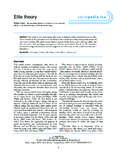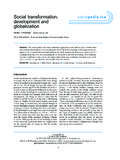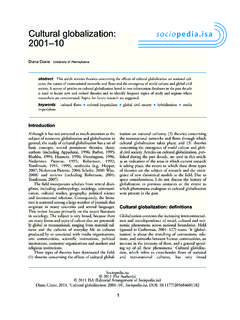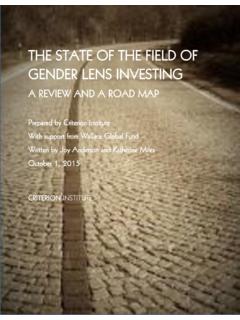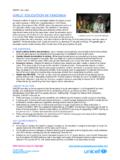Transcription of From sex roles to gender structure - SAGE …
1 2012 The Author(s) 2012 ISA (Editorial Arrangement of )Barbara J Risman and Georgiann Davis, 2012, From sex roles to gender structure , , DOI: study of sex and gender is now such a vibrantfield of inquiry in the social sciences that it is easy toforget how recently research and theory on the topicwas rare. At the start of the twentieth century, psycho-analysis was the state of the art, and the Electra andOedipal complexes presumed to account for sex dif-ferences. Much has changed since then. In this article,we offer an intellectual history of scientific researchand theory about gender , with particular although notexclusive attention to traditions developed in theNorth American context. We start with a briefoverview of the evolution of biological theories thathelp explain sex differences. We then discuss how psy-chological theories built upon research findings tosharpen the conceptualization of gender as a personal-ity trait throughout the twentieth century.
2 We focusmost attention on dueling theories, and subsequentintegrative ones within sociology. Here too, we arguethat theoretical arguments framed research that oftenrefuted the theory itself, thus spawning new researchtraditions. We discuss how sociology of gender hasfollowed a normative scientific model as it has devel-oped over time, with theories tested by research, andreformulated based on evidence. Research findingshave led to new theoretical formulations. In the con-clusion, we argue for the efficacy of using Risman s(1998, 2004) conceptualization of gender as a socialstratification structure with consequences for individ-ual selves, interactional expectations of others, andembedded in organizations because it helps to organ-ize and advance research, analysis, and social justiceprojects. The birth and evolution of biologicaltheories for sex differenceEndocrinologists, medical doctors with expertise onthe production, maintenance, and regulation of hor-mones, long believed masculinity and femininity to bethe result of sex hormones (Lillie, 1939).
3 WilliamBlair Bell, a British gynecologist, first made thisFrom sex roles to genderstructureBarbara J Risman University of Illinois at Chicago, USAG eorgiann Davis Southern Illinois University at Edwardsville, USAabstractThis article has two goals, an intellectual history of gender as a concept, and to outline aframework we suggest for moving forward theory and research on gender conceptualized as a structure ofsocial stratification. Our first goal is to trace the conceptual development of the study of sex and genderthroughout the twentieth century to now. We do this from a feminist sociological standpoint, framing thequestion with particular concern for power and inequality. We use a modernist perspective, showing howtheory and research built in a cumulative fashion, with empirical studies sometimes supporting and some-times challenging current theories, often leading to new ones.
4 We then offer our theoretical contribution,framing gender as a social structure as a means to integrate the wide variety of empirical research findingson causal explanations for and consequences of gender . Our framework includes attention to: the differ-ences and similarities between women and men as individuals, the stability of and changing expectationswe hold for each sex during social interaction, and the mechanisms by which gender is embedded into thelogic of social institutions and organizations. At each level of analysis, we are interested in the organiza-tion of social life and the cultural logics that accompany such gender structure sex stratification2 Risman and DavisFrom sex roles to gender structureexplicit in 1916 when he wrote the normal psychol-ogy of every woman is dependent on the state of herinternal secretions, and .. unless driven by force ofcircumstances economic and social she will haveno inherent wish to leave her normal sphere ofaction (1916: 129).
5 Gendered behaviors began to bejustified by sex hormones, rather than religion (Bem,1993). Further research discovered that the existenceof sex hormones did not distinguish male fromfemale, but rather both sexes showed evidence ofestrogen and testosterone (Evans, 1939; Frank,1929; Laqueur et al., 1927; Parkes, 1938; Siebke,1931; Zondek, 1934a, 1934b). It became clear thatestrogen and testosterone not only affected repro-duction and sex but also other aspects of the bodyincluding, but not limited to, the liver, bones, andheart (David et al., 1934). The possibility that sexhormones directly caused sex differences began to 1965, Young et al. suggested that sex hor-mones during gestation create brain differentiation,and thus were indirect causal agents for sex differ-ences (Young et al., 1965; see also Phoenix et al.,1959). Young et al. wrote, The realization that thenature of the latent behavior brought to expressionby gonadal hormones depends largely on the charac-ter of the soma or substrate on which the hormonesact.
6 The substrate was assumed to be neural (1965:179). This was quite a provocative claim when it wasmade, as it classified the brain as involved in repro-ductive functions. The brain began to be seen asresponsible for sexual differentiation, as well as sexu-al orientation and gendered behaviors (Phoenix etal., 1959). Although arguments about brain sex first origi-nated in the late 1950s and early 1960s (Phoenix etal., 1959; Young et al., 1965), there has recently beena resurgence of such research (Arnold and Gorski,1984; Brizendine, 2006; Cahill, 2003; Collaer andHines, 1995; Cooke et al., 1998; Holterhus et al.,2009; Lippa, 2005). Cooke et al. s (1998) reviewarticle concluded that there is ample evidence of sex-ual dimorphism in the human brain, as sex differ-ences in behavior would require, but there has notyet been any definitive proof that steroids actingearly in development directly masculinize the humanbrain (quoted in Diamond, 2009: 625).
7 Hrabovszkyand Hutson (2002) and Collaer and Hines (1995)claim prenatal androgen exposure is strongly corre-lated with postnatal sex-typical behavior. Juntti et al.(2008) have more recently argued that, at least formice, sex hormones are capable of controlling gen-der-specific behavior. In other words, contemporarybrain sex theories continue to be centered on howsex hormones in utero shape brain function. Brainsex theories of the twenty-first century maintain thatbrains are the intervening link between sex hor-mones and gendered behavior. Some sociologicalresearch (Rossi, 1983; Udry, 2000) presumes thatbiological sex differences interact with cultural expe-riences to exacerbate or diminish sex has been little concern with inequalitybetween women and men in this research , the goal has been to isolate biological contri-butions to sex on sex differentiated brains is not with-out its critics (Epstein, 1996; Fausto-Sterling, 2000;Jordan-Young, 2010; Oudshoorn, 1994).
8 For exam-ple, Jordan-Young (2010) conducted a syntheticanalysis of over 300 brain sex studies and interviewswith scientists who conducted them. She concludesthat brain organization research does not pass thebasic litmus tests for scientific research: they are somethodologically flawed as to produce invalidresults, because they rely on inconsistent conceptual-izations of sex, gender , and hormones. When con-ceptualizations of one study are applied to another,findings are often not usually replicated. The majordeficiency of brain theories of sex differences is thatthere are few consistent results across studies, andthey also depend on inconsistent definitions andmeasurement of concepts, and so lack validity. Thisresearch continues albeit mostly in the form of ani-mal research or quasi-experimental data abouthuman beings. Nevertheless, research continues butscientists only rarely integrate social and biologicaltheories (see an important exception in Udry, 2000,and the critical responses that followed: Kennelly etal.)
9 , 2001; Miller and Costello, 2001; Risman, 2001).The birth and evolution of social science attention to sex and genderFew social scientists were concerned with issues ofsex and gender before the middle of the twentiethcentury. The field has literally exploded in the lastseveral decades. Today, the Sex and gender sectionof the American Sociological Association is one ofthe largest sections of the organization, and in 2013,both ASA President and Vice-President are self-iden-tified feminist scholars who write about gender ,Cecilia Ridgeway and Jennifer Glass. In this section,we present a brief social history of the fast and furi-ous development of social scientific thought on sexand gender . We argue that during the heyday of functionalistsociology, family sociologists ( Parsons and Bales,1955; Zelditch, 1955) were those primarily interest-ed in sex and gender and wrote about women as the heart of families with male heads.
10 Psychologists(Bandura and Waters, 1963; Kohlberg, 1966) used3 Risman and DavisFrom sex roles to gender structuresocialization theory to explain how girls and boysbecame socially appropriate men and women, hus-bands and wives. Little research or theoretical writ-ing focused on sex or gender , and almost none oninequality between women and men (Ferree andHall, 1996). This changed as women entered theacademy (England et al., 2007). We choose to high-light in this article the research traditions that weidentify as having been the intellectual foremothersof where we are today. The psychological measurement ofsex roles Serious attempts to study sex and gender followedthe movement of women into science, and the influ-ence of the second wave of feminism on intellectualquestions. Psychologists ( Bem, 1981; Spence etal., 1975a) began to measure sex role attitudes usingscales that had been embedded in personality andemployment tests (Terman and Miles, 1936).

